Swiftech H2O-120 Compact and Corsair Nautilus 500: Is Water Better?
by Wesley Fink on September 17, 2007 6:00 AM EST- Posted in
- Cases/Cooling/PSUs
Swiftech H2O-120 Compact
Swiftech specializes in cooling for the enthusiast market. It is probably best known for its liquid cooling solutions, but Swiftech began with air cooling and has also had a few air coolers that were very well-known, like their ongoing MC and MCX air coolers for AMD and Intel. Swiftech also markets thermoelectric cooling parts, specialty ram and MOSFET coolers, and even a specially modified Antec P180 case called the QPower P180 for water cooling.
The Company was founded in 1994 by Gabriel Rouchon, incorporated in 2001, and was first publicly traded in 2005. Though there have been many changes in the company's structure over the years, it is worth mentioning that Gabe Rouchon is still very active in Swiftech, and Gabe often works directly with reviewers on tweaking the company's cooling products.
Swiftech markets both individual cooling products such as CPU water blocks, chipset and VGA water blocks, pumps, radiators, reservoirs, and cooling accessories. They also market complete water cooling kits such as the H2O-220 Apex Ultra and the H2O-80 Micro. Their newest kit, the H2O-120 Compact is the subject of this review.

The complete H2O-120 Compact kit comes packaged in a small box measuring roughly 13x7x4 inches. Everything needed for a standard Intel or AMD installation is included in the package.

The radiator/reservoir and water block/pump are well protected by the cutouts in the rigid foam block. Components are located on both the top and bottom of the Styrofoam. If you can't find the funnel it's mounted on the bottom.

You can see how much Swiftech has simplified this water cooling system by looking at the small number of parts compared to traditional water cooling kits. The fan/radiator/reservoir is basically one module, and the water block/pump is the second module. These two components are connected by pre-cut 10" Neoprene 3/8" tubes. All of the hardware for mounting is included, such as the mounting screws, Intel backplate (shipped attached to the Apogee Drive Block), a 7V electrical connector for running the fan at low speed, Arctic Silver Ceramic thermal grease, and the water additive. An alternate mounting block is also included for AMD/AM2 processor mounting.
Swiftech does not include the distilled water required for filling the system. Specialty cooling etailers and scientific equipment shops carry this; however, the most readily available source for distilled water we found is Wal-Mart, where a gallon of distilled water was less than a buck. The coolant additive is mixed with a half liter (pint or 16 oz.) of distilled water.
Installation
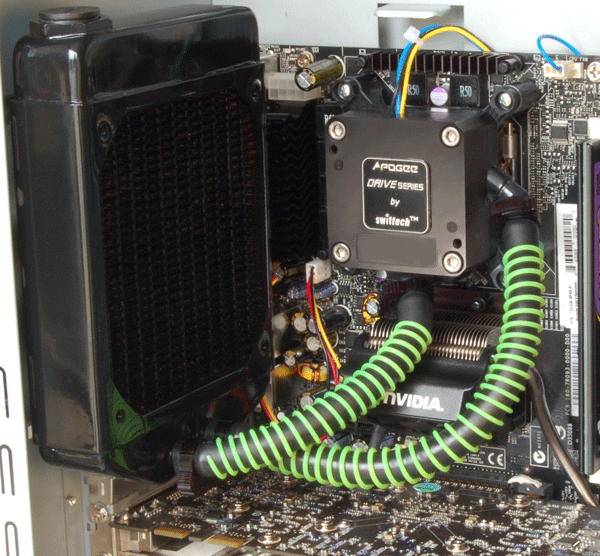
The kit mounts just fine in a full tower case, and it will mount fine in an Antec P180 which mounts the power supply at the bottom of the mid-tower case. The kit as supplied did fit any bottom-mount mid-tower case available for testing. However, the Swiftech H2O-120 Compact kit would not fit any top-mount power supply mid-tower case we tried. This included about six different brands of the most common top-mount PSU cases, either premium or value brands. The radiator is about a half inch too long to mount in top PSU mid-tower cases. Those equipped with 120mm exhaust fans all had screw holes that would not allow mounting of the radiator.
Both our old and new cooling test beds are top PSU mid-tower cases, and the H2O-120 Compact would not fit either case as supplied. We used that configuration because this is the case design readers most often own - it is the most common case available and accounts for the most sales. To be fair to other solutions, it was possible to find a way to install the H2O-120 Compact in the test bed case, so we could advise readers of what was needed to mount in this common design.
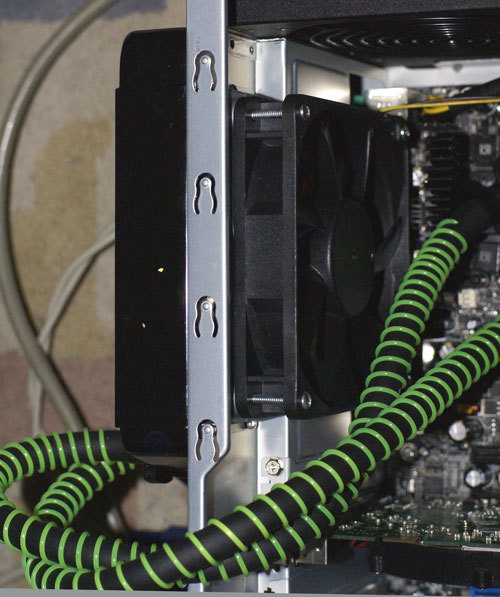
The easiest mount was a split design, where the radiator was mounted outside the case and the fan is inside the case. To use this mount you will need longer screws in some mid-tower cases and a longer pair of hoses. We found the 12" length worked fine in our case, and extra hoses are available from Swiftech.
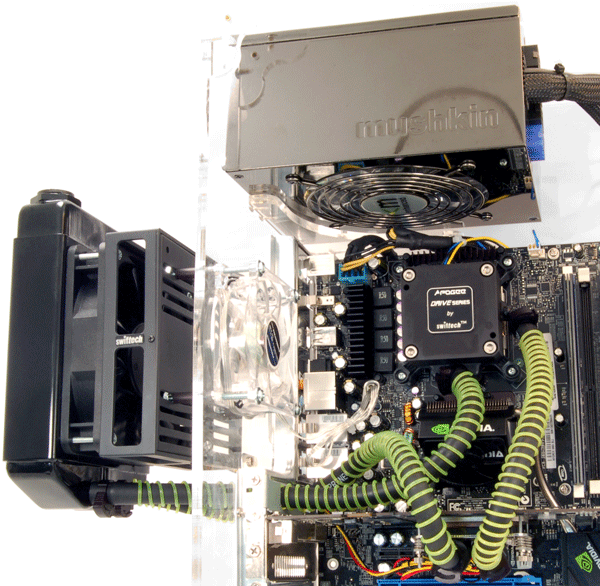
When there is not enough room for the radiator, Swiftech recommends using their "Radbox" for external mounting.
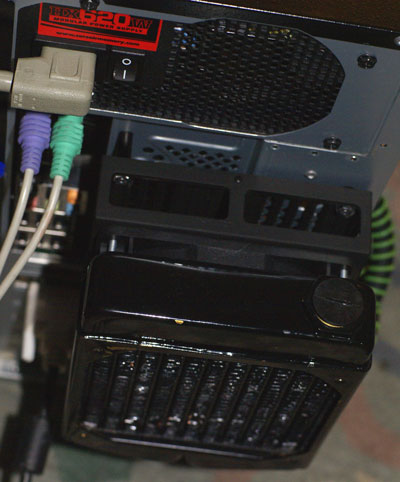
You will also need longer tubing for the Radbox install, but all the necessary screws and washers come with the Radbox from Swiftech. The Radbox kit even includes a PCI slot cover for running tubing to the outside of the case for external radiator mounting.
Performance tests were run with both the split-install configuration and the recommended Radbox external configuration. Cooling results were all but identical; the recommended external install was 0C to 2C cooler at most speeds. If your 120mm grill is not perforated enough you may have to remove the fan circle for best cooling, but the kit cooled fine on our test bed with the perforated 120mm grill intact.
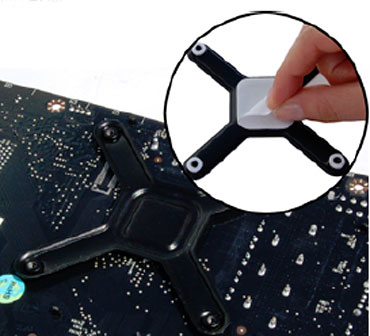
Once you have determined fit and decided on how you will mount the H2O-120 Compact you will need to assemble and leak test the water cooling system. The Intel 775 block requires a back plate so you will have to remove the motherboard to install the water cooling system. It was easiest for us to stick or tape the back plate to the motherboard and remount it for final install, because we strongly advise testing for leaks before mounting the system over the motherboard.

In a standard install everything is inside so you can attach the tubes, fill the system and operate the pump away from the computer. The manual includes information on how to run the power supply to test the system, before it is installed on the motherboard.
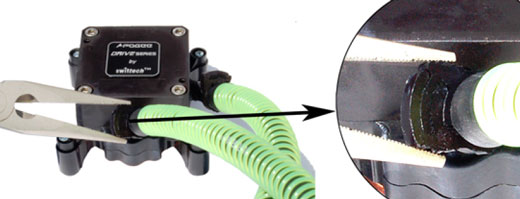
On the installs with the radiator outside the case you will have to plan assembly and water testing, since the water system should be filled after the tubes are passed through the PCI slot. The tubes for external mount were long enough that the Apogee block could dangle from inside the case to the outside for filling and leak testing. The apogee block was dangled over the back on a dry cloth for leak-testing where the tubing needed to pass though the PCI bracket.
The bottom line on installation is that the standard install is relatively simple, and it is definitely much simpler than the traditional four component water cooling systems. If you are a first-time water cooling installer and the system fits your case, 30 minutes is probably a reasonable time to install. However, if you are installing in a top PSU mid-tower case you will need to buy or order parts, carefully plan your install, and it will take an hour or more to install the system once your parts arrive. The penalty for a sloppy install without leak testing could be a dead motherboard and CPU, so we strongly recommend that you take your time and use the precautions necessary to assure you have a leak-proof water system.
Swiftech specializes in cooling for the enthusiast market. It is probably best known for its liquid cooling solutions, but Swiftech began with air cooling and has also had a few air coolers that were very well-known, like their ongoing MC and MCX air coolers for AMD and Intel. Swiftech also markets thermoelectric cooling parts, specialty ram and MOSFET coolers, and even a specially modified Antec P180 case called the QPower P180 for water cooling.
The Company was founded in 1994 by Gabriel Rouchon, incorporated in 2001, and was first publicly traded in 2005. Though there have been many changes in the company's structure over the years, it is worth mentioning that Gabe Rouchon is still very active in Swiftech, and Gabe often works directly with reviewers on tweaking the company's cooling products.
Swiftech markets both individual cooling products such as CPU water blocks, chipset and VGA water blocks, pumps, radiators, reservoirs, and cooling accessories. They also market complete water cooling kits such as the H2O-220 Apex Ultra and the H2O-80 Micro. Their newest kit, the H2O-120 Compact is the subject of this review.

The complete H2O-120 Compact kit comes packaged in a small box measuring roughly 13x7x4 inches. Everything needed for a standard Intel or AMD installation is included in the package.

The radiator/reservoir and water block/pump are well protected by the cutouts in the rigid foam block. Components are located on both the top and bottom of the Styrofoam. If you can't find the funnel it's mounted on the bottom.

You can see how much Swiftech has simplified this water cooling system by looking at the small number of parts compared to traditional water cooling kits. The fan/radiator/reservoir is basically one module, and the water block/pump is the second module. These two components are connected by pre-cut 10" Neoprene 3/8" tubes. All of the hardware for mounting is included, such as the mounting screws, Intel backplate (shipped attached to the Apogee Drive Block), a 7V electrical connector for running the fan at low speed, Arctic Silver Ceramic thermal grease, and the water additive. An alternate mounting block is also included for AMD/AM2 processor mounting.
Swiftech does not include the distilled water required for filling the system. Specialty cooling etailers and scientific equipment shops carry this; however, the most readily available source for distilled water we found is Wal-Mart, where a gallon of distilled water was less than a buck. The coolant additive is mixed with a half liter (pint or 16 oz.) of distilled water.
Installation

The kit mounts just fine in a full tower case, and it will mount fine in an Antec P180 which mounts the power supply at the bottom of the mid-tower case. The kit as supplied did fit any bottom-mount mid-tower case available for testing. However, the Swiftech H2O-120 Compact kit would not fit any top-mount power supply mid-tower case we tried. This included about six different brands of the most common top-mount PSU cases, either premium or value brands. The radiator is about a half inch too long to mount in top PSU mid-tower cases. Those equipped with 120mm exhaust fans all had screw holes that would not allow mounting of the radiator.
Both our old and new cooling test beds are top PSU mid-tower cases, and the H2O-120 Compact would not fit either case as supplied. We used that configuration because this is the case design readers most often own - it is the most common case available and accounts for the most sales. To be fair to other solutions, it was possible to find a way to install the H2O-120 Compact in the test bed case, so we could advise readers of what was needed to mount in this common design.

The easiest mount was a split design, where the radiator was mounted outside the case and the fan is inside the case. To use this mount you will need longer screws in some mid-tower cases and a longer pair of hoses. We found the 12" length worked fine in our case, and extra hoses are available from Swiftech.

When there is not enough room for the radiator, Swiftech recommends using their "Radbox" for external mounting.

You will also need longer tubing for the Radbox install, but all the necessary screws and washers come with the Radbox from Swiftech. The Radbox kit even includes a PCI slot cover for running tubing to the outside of the case for external radiator mounting.
Performance tests were run with both the split-install configuration and the recommended Radbox external configuration. Cooling results were all but identical; the recommended external install was 0C to 2C cooler at most speeds. If your 120mm grill is not perforated enough you may have to remove the fan circle for best cooling, but the kit cooled fine on our test bed with the perforated 120mm grill intact.

Once you have determined fit and decided on how you will mount the H2O-120 Compact you will need to assemble and leak test the water cooling system. The Intel 775 block requires a back plate so you will have to remove the motherboard to install the water cooling system. It was easiest for us to stick or tape the back plate to the motherboard and remount it for final install, because we strongly advise testing for leaks before mounting the system over the motherboard.

In a standard install everything is inside so you can attach the tubes, fill the system and operate the pump away from the computer. The manual includes information on how to run the power supply to test the system, before it is installed on the motherboard.

On the installs with the radiator outside the case you will have to plan assembly and water testing, since the water system should be filled after the tubes are passed through the PCI slot. The tubes for external mount were long enough that the Apogee block could dangle from inside the case to the outside for filling and leak testing. The apogee block was dangled over the back on a dry cloth for leak-testing where the tubing needed to pass though the PCI bracket.
The bottom line on installation is that the standard install is relatively simple, and it is definitely much simpler than the traditional four component water cooling systems. If you are a first-time water cooling installer and the system fits your case, 30 minutes is probably a reasonable time to install. However, if you are installing in a top PSU mid-tower case you will need to buy or order parts, carefully plan your install, and it will take an hour or more to install the system once your parts arrive. The penalty for a sloppy install without leak testing could be a dead motherboard and CPU, so we strongly recommend that you take your time and use the precautions necessary to assure you have a leak-proof water system.










58 Comments
View All Comments
rallycobra - Monday, September 17, 2007 - link
I'm building a new quad system, and I was going to go with the swiftech kit, and upgrade to a 120x3 radiator in the future. For now, I'm going to stick to air.Can you run the test again with a quad? Another site says that the swiftech outperforms all air solutions, but I trust your methodology a lot more.
Watercooling is elegant if you have the radiator outside the case, and you can cool the cpu, chipset and vga. It keeps the inside cool, and gets all of the heat out.
aigomorla - Monday, September 17, 2007 - link
Your upgrading to 3x the cooling power this article previewed.So if there saying a 120x1 will match a ultra120extreme, your saying 3x that cooling power isnt worth the migration.
*scratches my head*
This is what i mean about this article screwing people up in water migration.
poisondeathray - Monday, September 17, 2007 - link
Thanks for the interesting review.Given the increasing prevalence of quad-cores, it might be interesting to repeat the tests with an overclocked quad core configuration.
Although the testbed was different, at least 1 other hardware site got better results with similar watercooling vs. Tuniq.
gingerstewart55 - Monday, September 17, 2007 - link
I wonder what was wrong with your setups and your pumps. Having had the Corsair Nautilus 500 unit, and the pump the Swiftech kit is based upon, something is/was seriously wrong with your setup or pumps.The Corsair unit's fan, at least in the one I used, drowned out the pump completely.
The Laing pump in the Swiftech kit, the same pump in the Corsair kit by the way, is sitting in my computer and is utterly silent....completely drowned out by any of the four fans in the case....three Scythe S-Flex "E" fans, at 22 dBA on full speed, and an Antec SpotCooler on lowest speed (the Antec is the loudest fan in the case, btw.)
I'd almost hazard a guess that both kits, after being set up, still had a bubble/pocket of air in the pump. The Laing pump can get quite noisy if no completely bled of air.
Otherwise, there was a mechanical fault in both your kits' pumps as the Laing is almost completely silent when working as attested to by the hundreds of people using those pumps and hearing absolutely nothing from them when being used.
Nickel020 - Monday, September 17, 2007 - link
You need at mod top for the Laing pump, it's unbearable without one, but if decoupled almost unhearable with a good top.Wesley Fink - Monday, September 17, 2007 - link
We tested both systems as provided by Swiftech and Corsair. Both units are provided as complete kits and both manufacturers are familiar with our cooler test methods.Modding everything we test defeats the purpose of our comparative testing.
We are not finished with water cooling reviews, and we will be reviewing more water cooling systems in the future.
Nickel020 - Monday, September 17, 2007 - link
That's not hwo I meant it, of course you shouldn't mod the kits for testing. I was just saying that the Laing is not a bad pump for custom setups, in fact, it's pretty much the best pump for most setups if you use a mod top, which makes a big difference. I don't think I've ever seen a pic om someone using it without a mod top, but dozens with all kinds of mod tops.Wesley Fink - Monday, September 17, 2007 - link
I first thought there was a pump defect as well. So I acquired FIVE Apogee drive blocks from different sources and all measured similar dbA noise levels. There was also the 6th pump in the Corsair Nautilus 500.Subjectively the pumps were relatively quiet because the noise frequencies appear to fall in a freqency range that is not particularly annoying. However, our standard sound meter said measured noise was pretty high. We stated this in the review and also commented the pump noise was not annoying to our ears, but it may be to others. Measure the noise of your system and let us know what you find.
psychotix11 - Monday, September 17, 2007 - link
These two set-ups do not represent the top end of water cooling. It's long been past the point where a single 120mm rad is enough for a CPU.Toss these out and replace them with a custom set up with a dtek fuzion CPU block, 2x 120mm fan rad, ddc pump with petras top, and 1/2 id tubing and then see where it gets you.
Also liquid cool the chipset and then see if stock air can keep up (after), it won't.
You're taking two premade kits made for the user that has never water cooled before. It's simply not in the same category as the higher end custom kits.
Wesley Fink - Monday, September 17, 2007 - link
We did not state water cooling was always inferior to the top air coolers. We said, based on these test results and others we have run recently, that you would need to spend more than $300 on a water cooling system that might outperform the best air coolers.At more than 4 to 6 times the price of a top air cooler most readers would not conseder that good value.
I actually agree with your comments, but please tell us the total cost of the water cooling setup you say is needed to beat the best air coolers.